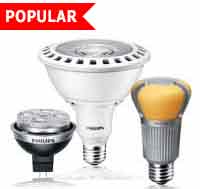Inventing a new socket for LED lighting
Thomas Edison surely did a good thing when he developed the screw-in socket for light bulbs. But the rise of LED lighting lets designers start from scratch with new connectors.
LED light source maker Bridgelux in a partnership with Molex early next year plans to start producing a new lighting component that dispenses with the classic screw base. Whether it becomes a de facto industry standard remains to be seen, but the product offers a glimpse into the design possibilities and technical challenges of solid-state lighting.
Rather than screw in, the disk-shaped Helion lighting module snaps into a base and gives off light from a coin-sized LED chip. The most significant aspect of the modules, though, is what's inside.
LED light sources require direct current, so a piece of electronics called a driver needs to convert the alternating current from the grid to a direct current.
The Helion modules include that driver right on the component, rather than having a separate "brick" to do the power conversion. That means the light source can be upgraded without having to match it with an updated driver.
"We think including the driver delivers future proofing. It simplifies the design integration and you don't need to worry about driver compatibility with the arrays," said Jason Posselt, the vice president of marketing at Bridgelux.
Having a replaceable AC lighting module opens up new design possibilities for lamp makers, who are the sought-after customers for the Helion module. Lamps themselves can come in different shapes and become multi-purpose appliances. For example, the module could include a networking chip so that the LEDs are controlled from a smart phone or lights could come with smoke detectors, said Posselt.
Bridgelux expects the snappable modules will be used by commercial customers initially but envisions the connector could be used for consumer lighting, too. LED light fixtures cost more than other lighting technologies but big electricity users, such as retail outlets, can get a one or two year payback based on the energy savings from efficient LEDs.
LED light sources are supposed to last for many years--tens of thousands of hours. But one could upgrade the Helion module to take advantage of improvements in cost and efficiency or to change light colors.
Posselt expects that there will be multiple connector types, led by companies and industry standards groups. But in the meantime, the snap-in module shows how technology is changing the shape of lighting.
Source: Cnet
LED light source maker Bridgelux in a partnership with Molex early next year plans to start producing a new lighting component that dispenses with the classic screw base. Whether it becomes a de facto industry standard remains to be seen, but the product offers a glimpse into the design possibilities and technical challenges of solid-state lighting.
Rather than screw in, the disk-shaped Helion lighting module snaps into a base and gives off light from a coin-sized LED chip. The most significant aspect of the modules, though, is what's inside.
LED light sources require direct current, so a piece of electronics called a driver needs to convert the alternating current from the grid to a direct current.
The Helion modules include that driver right on the component, rather than having a separate "brick" to do the power conversion. That means the light source can be upgraded without having to match it with an updated driver.
"We think including the driver delivers future proofing. It simplifies the design integration and you don't need to worry about driver compatibility with the arrays," said Jason Posselt, the vice president of marketing at Bridgelux.
Having a replaceable AC lighting module opens up new design possibilities for lamp makers, who are the sought-after customers for the Helion module. Lamps themselves can come in different shapes and become multi-purpose appliances. For example, the module could include a networking chip so that the LEDs are controlled from a smart phone or lights could come with smoke detectors, said Posselt.
Bridgelux expects the snappable modules will be used by commercial customers initially but envisions the connector could be used for consumer lighting, too. LED light fixtures cost more than other lighting technologies but big electricity users, such as retail outlets, can get a one or two year payback based on the energy savings from efficient LEDs.
LED light sources are supposed to last for many years--tens of thousands of hours. But one could upgrade the Helion module to take advantage of improvements in cost and efficiency or to change light colors.
Posselt expects that there will be multiple connector types, led by companies and industry standards groups. But in the meantime, the snap-in module shows how technology is changing the shape of lighting.
Source: Cnet

















Comments